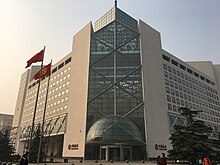Bank of China
 | |
 Bank of China Headquarters in Beijing, China | |
Native name | 中国银行股份有限公司 |
|---|---|
| Type | Public State-owned |
| |
| ISIN | |
| Industry | Financial services |
| Founded | 1912 |
| Founder | Chen Jintao |
| Headquarters | , |
Area served | Worldwide |
Key people | Liu Liange (Chairman & President) |
| Products | Credit cards, consumer banking, corporate banking, finance and insurance, investment banking, mortgage loans, private banking, private equity, savings, Securities, asset management, wealth management |
| Revenue | $73.23 billion[2] (2018) |
$33.07 billion[2] (2018) | |
$27.97 billion[2] (2018) | |
| Total assets | $3.091 trillion[2][3] (2018) |
| Total equity | $234 billion[2] (2018) |
| Owner | Government of China |
Number of employees | 306,322[4] (2021) |
| Subsidiaries | |
| Capital ratio | 16.91% (2021)[5] |
| Rating | A, A-1, Stable (S&P) A1, P-1, Stable (Moody's) A, F1+, Stable (Fitch)[6] |
| Website | boc.cn bankofchina.com bank-of-china.com bocusa.com |
| Bank of China | |||
|---|---|---|---|
| Simplified Chinese | 中国银行 | ||
| Traditional Chinese | 中國銀行 | ||
| |||
| Alternative Chinese name | |||
| Simplified Chinese | 中银 | ||
| Traditional Chinese | 中銀 | ||
| |||
| Second alternative Chinese name | |||
| Chinese | 中行 | ||
| |||
The Bank of China (BOC; Chinese: 中国银行; pinyin: Zhōngguó Yínháng) is a Chinese majority state-owned commercial bank headquartered in Beijing and the fourth largest bank in the world.
The Bank of China was founded in 1912 by the Republican government as China's central bank, replacing the Qing Dynasty's Ta-Ching Government Bank. It has been the second oldest bank in China still in existence after the Bank of Communications, founded in 1908. From its establishment until 1942, it issued banknotes on behalf of the Government along with the "Big Four" banks of the period: the Farmers Bank of China, Bank of Communications and Central Bank of the Republic of China. After the People's Republic was established in 1949, it has become a national commercial and foreign exchange professional bank. Its original central bank designation was carried on by the newly formed People's Bank of China.[7]
As of 31 December 2019, it was the second-largest lender in China overall and ninth-largest bank in the world by market capitalization value,[8] and it is considered a systemically important bank by the Financial Stability Board. As of the end of 2020, it was the fourth-largest bank in the world in terms of total assets, ranked after the other three Chinese banks.[9]
The Bank of China is legally separate from its subsidiary the Bank of China (Hong Kong), although they maintain close relations in management and administration and co-operate in several areas including reselling BOC's insurance and securities services.
History[edit]
The Bank of China's history began in 1905, when the Qing government established Daqing Hubu Bank[10] (大淸戶部銀行) in Beijing, which was in 1908 renamed to Daqing Bank (大淸銀行). When the Republic of China was established in 1912, Chen Jintao was named head of financial reform in President Sun Yat-sen's government. Chen Jintao transformed the bank into the Bank of China, becoming its founder.[11][12][13][14]
After the Chinese Civil War ended in 1949, the Bank of China effectively split into two operations. Part of the bank relocated to Taiwan with the Kuomintang (KMT) government, and was privatized in 1971 to become the International Commercial Bank of China (中國國際商業銀行). In 2002, it merged with Jiaotong Bank (交通銀行) to become the Mega International Commercial Bank. The Mainland operation is the current entity known as the Bank of China.
It is the second largest lender in China overall, and the fifth largest bank in the world by market capitalization value.[8] Once 100% owned by the central government, via China Central Huijin and National Council for Social Security Fund (SSF), an Initial public offering (IPO) of its shares took place in June 2006, the free float is at present over 26%. In the Forbes Global 2000 it ranked as the 4th-largest company in the world.[15]
It is the most globally-active of China's banks, with branches on every inhabited continent. Outside of mainland China, BOC also operates in 27 countries and areas including Australia, Canada, United Kingdom, Ireland, France, Germany, Italy, Luxembourg, Russia, Hungary, United States, Panama, Brazil, Japan, Republic of Korea, Singapore, Taiwan, Philippines, Vietnam, Malaysia, Thailand, Indonesia, Kazakhstan, Bahrain, Zambia, South Africa, and a branch office in the Cayman Islands.[16] In December 2010, the Bank of China New York branch began offering renminbi products for Americans.[17] It was the first major Chinese bank to offer such a product.
Although it is present in the above countries/territories, its operations outside China accounted for less than 4% of the activity of the bank by both profits and assets. Mainland China accounts for 60% of the bank by profits and 76% by assets as at December 2005.[citation needed]
You received this message because you are subscribed to the Google Groups "2top-manitotasy-2" group.
To unsubscribe from this group and stop receiving emails from it, send an email to 2top-manitotasy-2+unsubscribe@googlegroups.com.
To view this discussion on the web visit https://groups.google.com/d/msgid/2top-manitotasy-2/CAFHVOrv8sjuGa2ARSWkZhWbg7LqREQquGHFYBbfHo4cqziEDYw%40mail.gmail.com.
Comments
Post a Comment